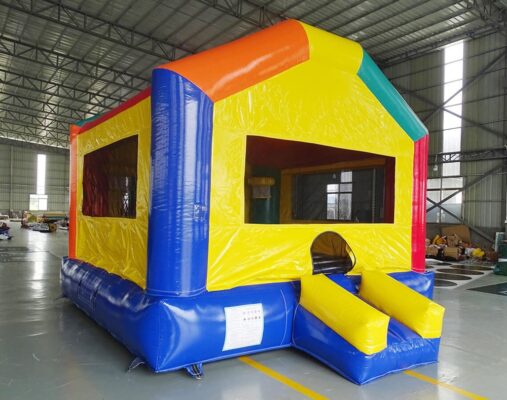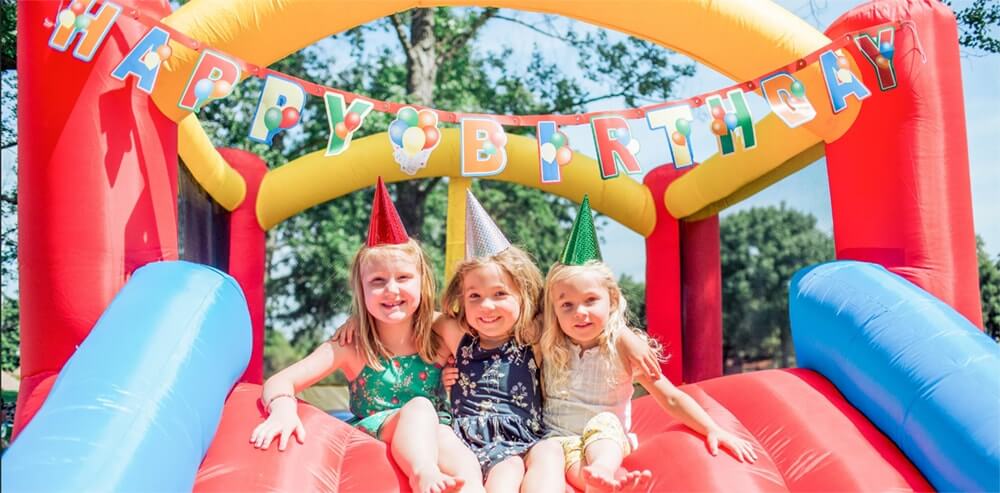Bouncing into the world of inflatables can be a thrilling adventure, but how do you choose between residential and commercial inflatables? Fear not, dear reader, as we guide you through the process. Let’s jump right in!
Residential Inflatables: For the Mini Bouncers at Home

Residential inflatables, perfect for your little ones, are designed specifically for home use. Suitable for kids, toddlers, and babies, they are made of lightweight nylon material or oxford cloth fabric, which unfortunately means they don’t have the longest lifespan. Let’s break down the key features of residential inflatables:
- Purpose: Home use
- Who can play: Kids, toddlers, babies
- Materials: Oxford cloth fabric or nylon material
- Size: Small, not larger than 20m²/215ft²
- Weight: 8 KG – 40 KG
- Price: No more than USD 500
- Service life: 6 months to 1 year, depending on the frequency of use
Residential inflatables are available at supermarkets like Walmart and Target, retail chains, online retailers like Amazon and eBay, and manufacturers like us.
Commercial Inflatables: Bringing the Party to the Public

Commercial inflatables, on the other hand, are designed for heavy-duty, commercial use. Suitable for both kids and adults, these inflatables are made of high-quality, lead-free, fire-resistant PVC material, ensuring durability and safety. Let’s dive into the world of commercial inflatables:
- Purpose: Commercial use
- Who can play: Kids and adults
- Materials: 15 oz & 18 oz Vinyl (PVC), 10 oz Vinyl Baffle inside
- Size: Large, normally larger than 10m²/108ft²
- Weight: >= 40 KG
- Price: Usually >= USD 500
- Service life: At least 2 years
- Order and Manufacture: Customization
Commercial inflatables are sold through manufacturers’ websites and other direct contacts.
Comparison List: Residential vs. Commercial Inflatables
| Kategori | Residential Inflatables | Commercial Inflatables |
|---|---|---|
| Purpose | Home use | Commercial use, rental, events |
| Users | Kids, toddlers | Kids and adults |
| Materials | Oxford cloth fabric or nylon material | 15 oz & 18 oz PVC Vinyl, 10 oz Vinyl Baffle inside |
| Boyut | Small, not larger than 20m² (215ft²) | Large, normally larger than 10m² (108ft²) |
| Weight | 8 KG – 40 KG | >= 40 KG |
| Fiyat | No more than USD 500 | >= USD 500 |
| Dayanıklılık & Service life | Lasts for 6 months to 1 year | Lasts for at least 2 years |
| Order & Manufacture | Bulk order and flow production | Customization |
| Customers | Retailers, wholesalers, distributors, parents, etc. | Inflatable rental companies, amusement parks, etc. |
| Sale Channels | Supermarkets, retail chains, online retailers | Inflatable manufacturer websites, direct contacts |
Choosing the Right Inflatable: Battle of the Bouncers
Now that we’ve laid out the key differences between residential and commercial inflatables, let’s help you choose the perfect one!
Budget: If you’re looking for a budget-friendly option, residential inflatables are the way to go. They’re cheaper but don’t expect them to last forever. On the other hand, commercial inflatables are pricier but built to last.
Kullanım: If you need an inflatable for occasional backyard fun, residential inflatables should suffice. But if you’re planning on frequent use or renting it out for events, go for commercial inflatables.
Size and Space: Residential inflatables are smaller and perfect for limited spaces. If you have a larger area and want an inflatable with more features, commercial inflatables are the better choice.
Age and Weight Limit: Residential inflatables are designed for younger children and have lower weight limits. Commercial inflatables cater to both kids and adults, accommodating higher weight limits.
Quality and Durability: You get what you pay for. Residential inflatables have a shorter lifespan due to their lightweight materials. Commercial inflatables, with their heavy-duty PVC construction, are built to last.
Where to Buy: If you’re after convenience, residential inflatables can be easily purchased at retail stores or online. For commercial inflatables, direct contact with manufacturers is the best route.
In conclusion, the decision between residential and commercial inflatables boils down to your needs, budget, and space. Think about how often you’ll use the inflatable, who will be using it, and where you’ll set it up. By considering these factors and weighing the pros and cons, you’ll be well-equipped to make the right decision for your bouncing needs.
Safety First: Bounce Responsibly

Regardless of whether you choose a residential or commercial inflatable, always prioritize safety. Follow the manufacturer’s guidelines for setup to ensure a fun and injury-free experience for all bouncers:
- Supervision: Always ensure that an adult is present to supervise the children while they’re playing in the bounce house. This will help prevent accidents and ensure that the kids are using the inflatable safely.
- Age and Size Limitations: Follow the age and size guidelines provided by the manufacturer. These guidelines are in place to protect the safety of the children using the bounce house.
- Limit Occupancy: Avoid overcrowding the bounce house. Adhere to the maximum occupancy limit recommended by the manufacturer to prevent accidents caused by collisions and falls.
- Proper Anchoring: Make sure the bounce house is securely anchored to the ground using stakes or sandbags. This will help prevent the inflatable from tipping over or being blown away by strong winds.
- Weather Conditions: Do not use the bounce house during extreme weather conditions, such as heavy rain, high winds, or lightning storms. These conditions can compromise the safety and stability of the inflatable.
- Proper Attire: Make sure children remove any shoes, glasses, jewelry, or other sharp objects before entering the bounce house. These items can cause injuries or damage the inflatable.
- No Rough Play: Encourage children to avoid rough play, such as pushing, shoving, or wrestling, while inside the bounce house. This can lead to injuries and accidents.
- No Food or Drink: Keep food, drinks, and chewing gum away from the bounce house to avoid choking hazards and prevent damage to the inflatable.
- No Flips or Acrobatics: Discourage children from performing flips, somersaults, or other acrobatic maneuvers inside the bounce house, as these can lead to serious injuries.
- Inflatable Maintenance: Regularly inspect the bounce house for any signs of damage or wear and tear. Address any issues promptly to maintain the safety and integrity of the inflatable.
- Cushioned Landing: Place a soft mat or cushioned landing pad at the bottom of the slide is a good idea to enhance safety because some bounce houses have no such cushion area. This additional padding can help absorb the impact and prevent injuries when children land at the end of the slide. Make sure the mat is thick enough to provide adequate cushioning and secure it in place to ensure it doesn’t move while in use. This extra safety measure will help create a more enjoyable and secure experience for children using the bounce house.
And remember, whichever inflatable you choose, the most important thing is to have a blast! Bounce houses, water slides, and obstacle courses can create unforgettable memories for kids and adults alike. So, go ahead and let your inner child soar – happy bouncing!
